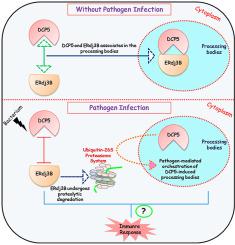Physiological and Molecular Plant Pathology ( IF 2.8 ) Pub Date : 2021-01-01 , DOI: 10.1016/j.pmpp.2020.101598 Gagan Kumar Panigrahi , Kunja Bihari Satapathy

|
Plants are equipped with numerous defense strategies to combat any biotic or abiotic challenges. Several protein factors are constantly engaged in the surveillance process, thus production of any aberrant messenger RNAs (mRNAs) and proteins are restricted. Eukaryotic mRNAs go through a number of scrutiny processes, whereby several protein components including mRNA decapping factors play a critical role in degrading the non-physiological mRNAs, which would otherwise have detrimental effect when translated. Similarly newly synthesized proteins also pass through quality control process mediated by chaperones and cochaperones harboured within the endoplasmic reticulum, ensuring proper protein folding and minimize the occurrence of protein misfolding. Interestingly, the results of the present study revealed that the decapping protein factor, DCP5 of the Arabidopsis thaliana physically interacts with the J domain-containing cochaperone, ERdj3B in the processing bodies (P-bodies). Upon pathogen infection by the Pseudomonas syringae pv. syringae B728a strain (PssB728a), the ERdj3B was induced for degradation via the 26S proteasome pathway as early as 120 min post infection (mpi). Also under pathogen-challenged conditions, DCP5 relocalizes to the cytoplasm and the number of DCP5-induced P-bodies was significantly reduced at 90 and 120 mpi. The findings of the present investigation highlight the possible significance of this interaction, primarily contributing for maintaining proteostasis and their plausible role during plant defense process.
中文翻译:

丁香假单胞菌 PV。丁香 香蒲 感染感染拟南芥J结构域的陪伴伴侣和去壳蛋白因子5的命运。
植物配备了多种防御策略,可以应对任何生物或非生物挑战。几种蛋白质因子一直参与监视过程,因此任何异常信使RNA(mRNA)和蛋白质的产生都受到限制。真核mRNA经历了许多审查过程,其中包括mRNA脱扣因子在内的几种蛋白质成分在降解非生理性mRNA中起关键作用,否则在翻译时会产生有害作用。同样,新合成的蛋白质也要经过内质网中分子伴侣和伴侣分子介导的质量控制过程,从而确保适当的蛋白质折叠并将蛋白质错误折叠的发生率降至最低。有趣的是,本研究的结果表明,降低蛋白质的因子拟南芥在加工体(P体)中与含有J结构域的伴侣蛋白ERdj3B发生物理相互作用。当病原体被丁香假单胞菌感染。丁香B728a菌株(Pss B728a),最早在感染后120分钟(mpi)通过26S蛋白酶体途径诱导ERdj3B降解。同样在病原体挑战的条件下,DCP5重新定位到细胞质,并且DCP5诱导的P体的数量在90和120 mpi时显着减少。本次调查的结果突出了这种相互作用的可能意义,主要是为了在植物防御过程中维持蛋白稳态及其可能的作用。











































 京公网安备 11010802027423号
京公网安备 11010802027423号